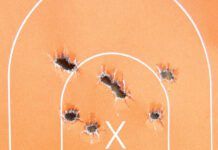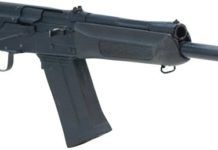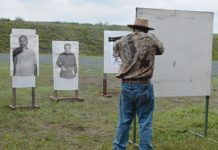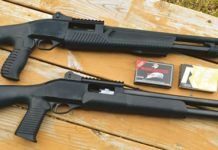In this installment of our continuing tests of personal-defense loadings, we had to don our thinking caps. Shotgun shells are far different in performance than a handgun cartridge or rifle round. The standards are different as there is no X ring or group to measure. The density of the pattern is the primary consideration. Measuring the effectiveness of buckshot is simple as regards measuring a pattern, but a buck-and-ball load would be another matter. Slugs are another area of concern.
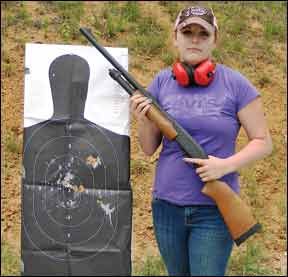
Recoil is an important consideration as well. In the past, the primary problem with shotguns for personal defense was recoil. Even big burly police officers reached their limit quickly with full-power buckshot loads. The solution for many was to engage in tactical training with birdshot loads and deploy buckshot for duty after a modest familiarization. This was not the ideal program. Then came the reduced-recoil buckshot loads. By reducing the payload from nine to eight buckshot balls (in some cases) and reducing velocity by several hundred feet per second, a buckshot load that was both effective and controllable was invented. These loads are controllable, and as a bonus, usually produce a dense and effective pattern at close range. They are intended for use at ranges inside 15 yards. The full-power or even stronger Magnum shotgun shell loads are intended for tackling deer-size game out to 50 yards or so – a very different scenario than home defense. The homeowner in search of an effective shotgun load for his personal-defense shotgun does not need this type of power. They need a load that is about as powerful at 7 yards as the Magnum loads are at 50 yards. Citizens are better served with a dense pattern and moderate velocity at close range. Public safety is served with less penetration.
A relatively dense pattern is desirable for effect on the target. However, there are trainers who tell us that the greatest advantage of the shotgun is seen at about 15 yards. At this range the pattern has spread to the point that you are more likely to get a hit without a perfect sight picture. If five or six of the pellets strike the target, you will probably have a stopping shot. Experienced trainers commonly refer to the different viable shotgun ranges as A, B, and C range. A range is the distance at which the shotgun must be aimed as carefully as a rifle. B range is the range at which the shotguns spread is most profitable. C range is the range at which the pattern is so broad it is no longer useful. C range is usually 20 yards with an open choke shotgun. C range is slug range.
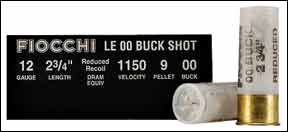
There was some discussion concerning the selection of the loads to be tested. We left much of the testing to the primary rater by dint of his extensive law enforcement experience. We noted that while these loads are reduced-recoil and lower velocity than full-power buckshot loads, they are no lightweights. These loads produce respectable power. We tested one full-power buckshot load, as an example, and the total package gave an energy count lower than some of the personal defense loads tested. Even the least powerful 12-gauge load tested exhibited about 1200 pounds of energy. This is about three times the energy of the standard handgun loads we have tested. No wonder the shotgun has such a reputation for effect! The raters agree that the 12 gauge is by far the superior option. No other gauge offers the versatility and effect of the 12 gauge.
The test team leader remarked that buckshot is misunderstood. The pattern has advantages in more than one dimension. Few shooters realize that buckshot travels in a string. We see only one dimension in the target. As an example, if the target is moving, part of the string may miss, but the target may run right into the latter part of the string. It takes a lot of shooting to get a good handle on buckshot performance. Once you do, you will have a great respect for the performance of buckshot. You will also understand the limitations of range.
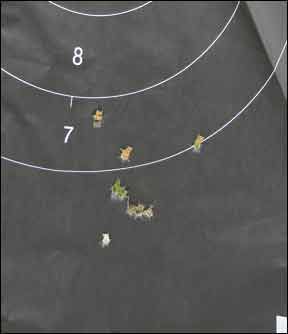
We included one “Law Enforcement Only” load for comparison and really had only a few shells on hand. As far as the LE-only loads, most are available through one distributor or the other or at gun shows. When comparing LEO loads to standard fare, our conclusion was that there is no need to haunt the gun shows and pay through the nose for LEO shotgun shells. The readily available personal defense loads do at least as good a job, as you will see in the comparison tables. Some may even be the same load under a different label. The test shotguns were three Remington 870 shotguns and one H & R Pardner-type defensive shotgun, basically a copy of the 870 with a humpback. The barrels were 18 inches long with rifle sights and open choke. While shotguns are often individualistic with patterning, there wasnt a nickels worth of difference between these, as our raters noted. We fired the shells and rated the apparent recoil of each. We noted whether they struck to the point of aim and noted if the pattern was centered on the front post or front bead.
Recoil was treated subjectively. Since these loads are designed to be used by anyone interested in personal defense, we enlisted two interested shooters. These fine young women were invaluable raters. One is a Criminal Justice Major and the other is a young soldier. Their perspective on the differences in recoil was keener than those of battered old cops that have fired a few thousand 12 gauge shells in their day. We fired the shotguns at 7 yards, the generally-agreed upon range that personal-defense engagement most often occurs. The old rule that a pattern spreads 1 inch per yard is probably applicable to these loads. Just the same, a 21-foot gun battle inside the home would be rare. Most battles would be closer. The 7-yard distance was chosen to give a good impression of the pattern to be expected.
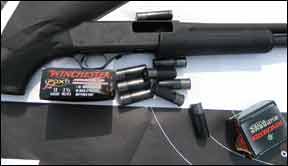
Heres how our load selections performed.
Hornady Critical Defense Ammunition
12 Gauge 2.75-In. 00 Buckshot
No. 86240, $11.79/10 (Midway #151704)
This had a payload of eight buckshot balls and was the most powerful loading tested by a slight margin (11 foot-pounds of energy over the Winchester PDX load). Its Versa Flite wad is designed to trap air in a special section of the wad and rip the wad away in the air and deliver an effective pattern. This is exactly what happened.
The load dispersion at 7 yards averaged 2.75 by 2.5 inches during the testing. This is a good, tight pattern and the tightest demonstrated. Our raters with LEO and deer-hunting experience were favorably impressed with the Hornady loading. Despite the 300-fps advantage in velocity over other loadings, the Hornady load was not rated as a hard kicker. The pattern struck the point of aim, and, interestingly, the wad struck the paper at 7 yards, usually about 6 inches from the main pattern and to the right. The Hornady load is designed to be reliable in modern automatic shotguns such as the Benelli, the FN patrol shotgun, and other types.
Our Team Said: The Hornady Critical Defense load is rated a top performer on several counts. First, performance was excellent. The tight pattern delivers the loads energy in a finite area. Second, the price for ten shells was reasonable. And if you use a self-loader that demands full-power energy for function, there is no other choice.
Winchester Super-X
12 Gauge 2.75-In. Buffered 00 Buckshot
No. XB1200, $4.99/5 (Midway #337006)
This is a traditional 9-ball full-power loading that was included for comparison. The Super X has an advantage in price because these shells are affordable, if not as high-tech as the Personal Defense
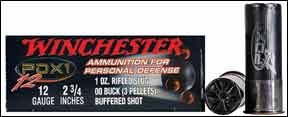
loads. The Super X exhibited the greatest recoil, typical of full-power buckshot loadings. This is the reason the loads were developed. The pattern was wide at 6.75 by 5.5 inches. In our experience these full-power loads do much better in tighter chokes than the PD loads.
Our Team Said: While we prefer the purpose-designed PD loads, bad guys would be well advised to stay out of the way of the Super X loading.
Winchester Supreme Elite
Self Defense Ammunition
12 Gauge 2.75-In. Bonded PDX1 S12PDX1,
$14.49/10 (Midway #932564)
Here is a load with almost a ton of energy. In addition to the three pellets of Grex-buffered 00-buck copper-plated pellets (0.5-ounce total for all three), this load also features a 1-ounce rifled slug loaded in black hulls with a black-oxide high base. There are three wads protecting the shot column and ensuring efficiency. These include a quarter-inch hard-plastic wad over the powder charge, a 5/16-inch cushioning wad next, and a harder 3/16-inch wad. While the wads have a ballistic purpose, they also pattern on the target along with the payload up to about 5 yards or so. For those who prefer a slug but like to have the backup hit probability of buckshot, this is a winner. It is similar in purpose to the old buck-and-ball loads used in blackpowder rifles as late as the War Between the States. A lead ball and smaller buckshot was used in smoothbore muskets. The theory was you would surely hit something at short range, but on the other hand, if you needed a long shot, the heaviest ball would carry the distance. The modern Winchester load
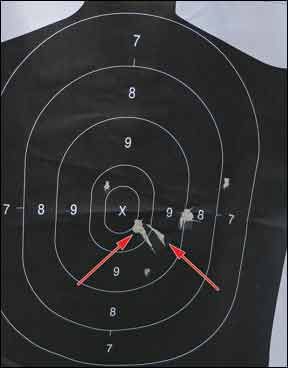
offered interesting performance. The slug and two of the balls usually were dispersed by 4 inches horizontally but only an inch vertically. So, the pattern was 4 inches wide by 1 inch high for three projectiles. The third ball brought the measurement to 4 inches wide by 6 inches high, still perfectly acceptable and very consistent.
Our Team Said: While the number of projectiles was the least of any load, the total weight was the greatest with the 1-ounce slug included. Striking to the point of aim, this load is consistent. The PDX load will be effective at short range, while the slug would be effective to 50 yards or more without attempting to change the load for a long-range shot. That is versatility. A winner on innovation, the PDX is pricier than the other loads but much more difficult to produce considering the multiple projectiles and special wadding. As such, the price is reasonable, we believe.
Winchester WinLite Low Recoil Ammunition
12 Gauge 2.75-In. 00 Buckshot
WL1200, $4.99/5 (Midway 620922)
Winchesters WinLite offering is simply a reduced-recoil loading. This nine-buckshot load predates the buck-and-ball load. For personal defense in the home and general chores, the WinLite works just fine. The WinLite is about half the price of the Winchester PDX load.
Our Team Said: If the WinLite is a completely effective load, why bother with the heavier PDX? Sometimes we like greater energy and power, and the PDX has it. But our shooters said that WinLite offered the lightest recoil of any load and acceptable performance.
Federal Premium Personal Defense Ammunition
12 Gauge 2.75-In. Reduced Recoil 00 Buckshot
No. PD13200 $5.49/5 (Midway 121561)
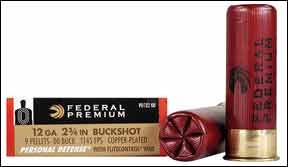
Offered in a five-round box, the Federal personal defense load is a simple solution to the problem of wielding a shotgun effectively. The buckshot pellets are copper plated and are loaded nine to the shell. Here is what the Federal load has going for it – among the lowest subjective recoil of any load tested. One rater asked, “Are you sure we are getting the advertised horsepower?” The Chrony confirmed we were getting the full 1126 fps. The pattern was more than acceptable at 4 by 3.5 inches
We included the famous Federal law-enforcement eight-shot reduced-recoil loading primarily as a reference load, wondering if the PD was simply the LE under a different logo. Perhaps it is. A handful of the LE shells were supplied by one of our cop friends. The LE ran slightly faster than the PD load, likely a function of having one fewer shot in the payload, but it could also mean that it was simply put up in a different lot. The LE pattern was marginally larger than the PD loading, which may mean little.
Our Team Said: The Federal PD load burns cleanly and offers a low-recoil solution for homeowners. It is certainly enough for the job, and the lower recoil of the load gives every advantage in rapid backup shots. All in, our raters said the Federal LE shell was a good load, but it was not something worth traveling to the gunshow and paying top dollar to obtain.
Fiocchi Reduced Recoil Ammunition
12 Gauge 2.75-In. 00 Buckshot No. 12LE00BK,
$6.29/10 (Midway #482134)
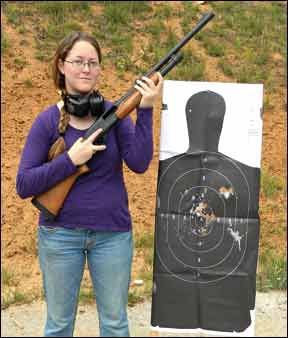
These nine-pellet loads are a relatively new addition to the Fiocchi line; at least we have not been previously aware of them. The Fiocchi load demonstrated a clean powder burn and low subjective recoil, as may be expected from a load generating a modest 1090 fps. This load has a lot going for it. First, the buckshot is plated. Some like plated shot; some do not, but the difference in recovered pellets and in penetration was not a consideration. The pattern was tight enough for a solid recommendation. As an experiment, we fired the Fiocchi load at 10 feet and measured a 2 by 3-inch pattern – there is still dispersion even at this close range.
Our Team Said: Plated shot doesnt seem to offer any practical advantage, but here it is at a great price. And the price point is important. The Fiocchi load is a certified Best Buy. After some research, we found the load for even less at Cheaper Than Dirt ($5.39/10). That is the same price as five rounds from other makers. That is real economy with quality thrown in.



